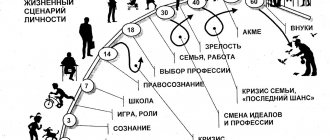Greetings, friends!
Imprinting is an interesting psychophysiological phenomenon that is observed in both animals and humans. It lies in the fact that at certain moments the memory of a living being is triggered in a special way, forever imprinting certain feelings or actions.
In most species, this mechanism is used to ensure the survival of the individual and the reproduction of offspring, but for humans it has evolved into something more. Today we will analyze in detail what imprinting is, what it is like and how it works from a psychological point of view.
Definition
Imprinting (from the English Imprint - imprinting) is a type of memory for acquiring experience or skills. Occupies an intermediate stage between innate instincts and learning. This term refers to the psychophysiological mechanism by which the brain records impressions perceived by the body at a certain age stage. The imprinting occurs within an instant and is practically impossible to change.
Imprinting in psychology
The term imprinting came to psychology from animal psychology. The Austrian scientist in the field of biology K. Lorenz, based on an analysis of the behavior of representatives of the fauna, studied the imprinting and further habits of humans. At first it was assumed that the imprinting mechanism works only in the initial period after birth, because adaptation to the environment in young animals occurs faster than in humans. In animals, imprinting is based on instinct, which is necessary for survival.
For people it has a deeper purpose. It occurs without a clear age limit: during the period of growing up, personality formation, as a result of traumatic situations and adaptation in the social sphere. All this is the success of human survival.
The occurrence of imprinting at a young age occurs more often and more intensely, especially at such important moments as:
- admission to an educational institution;
- starting or changing a job;
- moving to another place of residence;
- change of social status.
There are a lot of similar situations, and the stronger the stressful moment, the faster the subcortical imprinting occurs. Sometimes a person does not remember under what circumstances the stress occurred, so the experience manifests itself in behavior automatically.
Signs
Imprinting in psychology is a process that usually occurs in early childhood. However, there are known cases of later imprinting. The results of this process are irreversible and are very difficult to change further.
Imprinting is characterized by the following features:
- occurs quickly, after a single contact with the object;
- does not require any type of reinforcement;
- happens in a limited (often crisis) time period;
- is irreversible;
- associated with cultural phenomena;
- affects the rest of your life.
Genomic imprinting
American geneticist H. Crouse, based on research on genetics, gave the concept of genomic imprinting. It appears in both humans and animals.
Gene imprinting is an epigenetic mechanism in which one part of the genes is transferred to the offspring from the father, and the second from the mother.
But there are other genomic imprinting. Examples may be different: a child may exhibit other hereditary abilities that the parents do not have, but early generations of relatives possessed. The same thing applies to external data.
Such imprinting sometimes entails negative genetics. From previous generations, a child may inherit the risk of pathologies and unwanted syndromes.
According to statistics, people with an optimistic attitude have better health and live longer than pessimists. Therefore, they try to cheer up a sick person and lift their spirits, because... Positive emotions help people recover faster.
Imprinting is also used in medicine. The study of fragments of genetic material allows us to identify hereditary diseases. Diagnosis is carried out at any age stage, including prenatal.
Working with imprinting phobias
A phobia is the fear of something. It differs from fear in that it is practically uncontrollable behavior. If a person is simply afraid of spiders, then his health indicators will not change when meeting an arthropod, but if a person has a phobia, then a panic attack may occur.
Work with impressions based on the type of phobia can be structured as follows:
Photo by Markus Distelrath from Pexels
- you need to create a visual image of a spider in your apartment. Choose a photo that, in your opinion, most fully reflects the type of phobia. It may be a large, venomous, brightly colored spider;
- print this photo and place it on your refrigerator or desktop. Also put an image of a spider on your phone and desktop screensaver on your computer. This easy step will allow your subconscious to constantly be on your toes and read the safety of a visual image;
- read a book about spiders, but always with pictures. Visit a spider exhibition and try to pet a representative of a non-venomous species (under the supervision of the owner, of course).
These recommendations must be followed systematically so that the subconscious begins to work in a safe mode. This takes a long time, since you have probably had the phobia for many years. At the same time, it can be anything - fear of objects, animals, phenomena, and even fear of phantom events.
In psychology, there is a rule of processing: everything that is in our subconscious can be corrected over a long period of time—exactly half the time it took for you to develop a psychological phenomenon. If you have been afraid of spiders for more than 10 years, then processing phobias in the subconscious will take about 5 years. In fact, with targeted work, the time frame is significantly reduced. Also here the willpower of a particular person is of great importance.
Photo by Anna Shvets: Pexels
Imprinting - examples in humans
General knowledge about human consciousness provides an answer to the question about the stage of readiness of the neuropsychic system for imprinting. Research into this phenomenon has primarily focused on prenatal psychology and the postnatal period.
The Austrian psychologist S. Freud argued that birth is the first psychological trauma. This definition has a name - catharsis. The term is included in the Medical Encyclopedic Dictionary.
Oral
Primary imprinting is called oral, because. For a newborn, mother's milk is the only source of survival. The mother's breast and hugs give the baby a zone of comfort and a sense of security. This is considered the starting point from which future expansion of the safe zone begins.
Territorial-emotional
A person needs personal space and mastery of his status from early childhood. This is expressed in the choice of place for games. The scattering of toys by a child is a kind of “mark” of his territory.
In adulthood, a person develops the territory in the form of moving to another place of residence, registering ownership of the land and house. The level of training determines what role he will play in society: dominant or subordinate.
Verbal
Speech and its recognition among other sounds, as well as thinking and recognition of symbols, depend on this type of imprinting. Verbal imprinting is a person's way of communicating.
Social
Formation of different types of imprints based on the main values and interspecies relationships. Imprinting as a result of communication with a person can be both positive and negative. Involuntary absorption of information occurs and subsequent imitation of behavior or activity occurs.
Social imprinting is of great importance in relation to religion, family, choice of marital partner, and also influences abilities and hobbies.
Problems and disorders in the sexual sphere directly depend on social imprints.
What age is it typical for?
Psychologists do not have a consensus on exactly what age the first imprinting occurs. Researchers of newborn children J. Tsaregradskaya, M. Auden, G. Dick-Read believed that there is a period of several hours when the child is open to imprinting. This opinion is criticized by a number of other scientists, as it relies on the knowledge of animal psychology, thereby identifying humans and animals.
The hypothesis of psychoanalyst J. Bowlby, who studied the theory of attachment, states that the critical period does not last several hours. In his opinion, this gap continues until the child is able to move independently and follow a significant adult.
Bowlby identifies several phases when a person is susceptible to imprinting:
- From birth to 3 months. Babies at this age indiscriminately respond to people in the same ways. They love to listen to human speech and look at people's faces at close range. A positive response from a child is considered to be humming, babbling, and socially smiling. At first, they spread to everyone in contact with the baby, and later the child reacts to a specific familiar object.
- From 3 to 6 months. During this period, infants become selective in their contacts and focus their attention on familiar faces. This is how children stop smiling at strangers and just watch them. The child exhibits humming, crying and other types of non-verbal communication only in the presence of those he knows. In addition, from 5 months, children begin to reach out to familiar people and grab them.
- From 6 months to 3 years. From the age of six months, a child begins to show attachment to a specific adult, a parent. At the same time, there is a fear of strangers and a fear of separation from the mother, to which children react with loud crying. Also at this time, the child begins to actively crawl and walk - to master the world around him, watching the adult, without letting him out of sight. This is how imprinting on a specific person is expressed.
- From 3 years to the end of childhood. After 3 years, the influence of the imprinted object on the child decreases. The parent ceases to be an object of pursuit and gradually becomes a partner in the relationship.
Consequently, infants and young children are susceptible to imprinting from the moment they have identified a significant familiar adult from the entire set of people in contact with him.
It is this person who becomes the object of pursuit and influences the possible imprinting of the child. At school and adolescence, children go beyond the boundaries of the family, so there are more people to capture. This is how peers and other adults become role models.
T. Leary's theory (seven circuits)
The circuit model was interpreted by T. Leary as a connection with a certain stage of biological or social development. Circuits are a system of levels of consciousness concentrated on one of the stages. The American psychologist noted seven imprints and constructed a model of consciousness.
More than 9,000 people have gotten rid of their psychological problems using this technique.
Biosurvival
The survival stage is determined at an early age. A person identifies safe and hostile places for himself.
Everything that happens at this stage is reflected in the following character traits:
- confidence or anxiety;
- thirst for research;
- independence or complete subordination.
In a dangerous situation, biosurvival takes over the human brain and acts as an unconditioned reflex. For example, a person is threatened with a weapon. Biosurvival will decide whether to escape or neutralize the criminal. After time passes, a person does not remember when the moment of making this decision occurred.
Emotional-motor
It occurs at the stage when the baby stands on his feet and begins to walk. The struggle for dominance within the family begins. The imprinted status level automatically works in the future.
The importance of imprinting must first be realized by parents who are raising a child. Imprinting in young children occurs on a subconscious level, and negative stressful situations can negatively affect their behavior in the future.
At this stage, the following qualities are determined in a person:
- dominance or subordination;
- self-confidence or doubts;
- strong or weak ego;
- status level.
The loser imprint in the emotional-motor circuit system will feel insecure, angry, and anxious. If he accidentally becomes the master of the situation, the feelings will be the same.
Mentally manipulative
During this circuit, the child begins to comprehend language and speech. This imprint is responsible for thinking and creating maps of reality. As the amount of information increases, thought processes operate faster. New maps of reality in the future influence the creation of technologies that unpredictably change psychological, economic and political relationships.
The mental manipulation circuit influences such factors as:
- speech quality;
- dexterity of movements;
- speed of consideration.
This imprint is a system responsible for the coefficient of unpredictability. This stage pushes back evolutionary norms and works as a revolutionary factor.
Sexual-social
During adolescence, a child develops a sexual personality. First of all, morality is established, which ensures the process of civilization. This creates an attitude towards family, nation, and state.
At this stage, an adult personality emerges with such qualities as:
- moral;
- humility;
- integrity;
- parenthood.
The sexual-social circuit is responsible for establishing moral standards, procreation and raising children.
Pleasure Circuit
A level of consciousness that opens the human body as a way of pleasure. It is presented in the form of yoga, hypnosis, shamanism. Controls pleasure, bliss, the “high” reaction, faith healing.
Circuit of Ecstasy
This imprint comes into effect when the nervous system becomes aware of its control over the body. The person falls into ecstasy, enjoying its intense functioning.
Neurogenetic
The system is collective, because combines all stages of evolution. Activates the work of everything unusual and phenomenal in the human nervous system. The type of neurogenetic circuit includes mythical heroes who control people’s consciousness.
Mechanism
Imprinting in psychology is a transitional mechanism between a conditioned reflex and instinct. Researcher G. Horn conducted experiments on animals, as a result of which he found out that each species in the nervous system has an innate tendency to imprint.
It is activated by visual, olfactory or other sensory stimuli. After the individual was administered a certain substance, the area of the brain responsible for the formation of imprinting was traced using radiographs. It turned out that this area is the medioventral hyperstriatum.
The fewer genetically formed programs, the stronger the imprinting influences life. Humans, unlike animals, have virtually no built-in genetic programs. Therefore, at the beginning of life, imprinting has a great influence on the subsequent development of the foundations of behavior and perception of reality.
Imprinting on the past was used to demonstrate values and social norms to the younger generation. This usually happened during the process of initiations - initiation rituals, which were accompanied by a stressful state of the participants. Thus, during the initiation, emotional images were transmitted that contained the semantic and cultural norms of a particular group.
As you grow older, imprints overlap and they begin to influence each other. Under the influence of accomplished imprinting, a way of perceiving the surrounding world and people develops, on which a person relies in life.
The difference between imprinting and conditioned and unconditioned reflexes
Imprinting is a system of acquired behavior. It is characterized by automaticity of actions and is only a small step in comparison with innate and acquired instincts.
Unconditioned reflexes (innate) provide for certainty and an established structure of behavior. A person is born with them and cannot be learned. The innate reflex does not allow mistakes in certain situations. For example, sneezing, withdrawing your hand from a hot iron, closing your eyes when objects approach. Every person performs such actions from birth.
Conditioned reflexes (acquired) are more risky. If the educational process is not organized correctly, the necessary pattern in behavior may not arise. This model is compensated by flexibility in adapting to changing situations.
Interesting Facts
We constantly encounter sensations that seem unusual and absurd to us, but in the end they turn out to be true. For example:
- The girls' bodies have several times more pain receptors than the boys' bodies. As a result, nature has created a protective system to increase the pain threshold. Therefore, males tolerate pain worse than females.
- People with high IQs dream and remember them. During a sudden awakening, they are lucid.
- When a person frowns, the body burns calories. Based on this, you can benefit: if you look at everyone with a hateful gaze, you will have a free opportunity to lose weight by summer.
There is a lot of incomprehensible and unexpected things in people's lives and behavior. Many facts look like mysteries, which the theory of imprinting helps to reveal.
If you don’t want to give up and are ready to really, and not in words, fight for your full and happy life, you may be interested in this article .
several specific examples (or scenarios) of how an imprint manifests itself in a person’s life.
Example (scenario) First: “Wow! Give me two!”
As a child, the father abused (or was simply rude) towards his daughter or her mother - his wife.
What imprint does a daughter get when she grows up and it becomes important for her to find a partner?
This young woman will have the best relationships only with those men who will treat her rudely and show strong aggression towards her.
She will “look out” from the crowd of men only for those who (in her opinion) are capable of aggression towards her.
With her persistent provoking behavior, this young woman will “tempt” a non-aggressive partner into aggression - and if she achieves her goal, she will experience pleasure and, perhaps, “love” him, discovering the “man” in him...
Incredibly accurately, a woman with a similar imprint was described in her song by the poet-bard Elena Bushueva:
I can see my destiny - to jump on the lion's back And drag it by the tail and ruffle its mane And look into the eyes and scratch behind the ear It's all a game to you. Nice toys!
Where can one play here - when one has completely exhaled When every day is full of insults When the sky suddenly stopped dreaming Oh, God forbid you marry me.
You would have to become a terrible filibuster To get me out of forgotten towers To rescue me from passing ships To take me away from momentary friends.
To wean me from cheap boredom To receive me from someone's arms And to look for me in big hotels To get me out of other people's beds
And to slap me on the shameless cheeks In my genuinely red eyes And to frighten me with a filibuster's word And to love me every hour - again...











